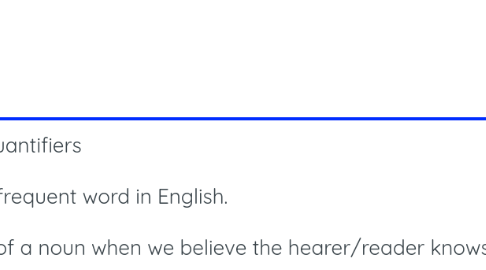
1. 1.1Tenses
1.1. Past Tenses
1.1.1. Mainly in the Methodology and Results Section
1.1.2. Use the past tense for describing experiments that have been conducted and the results of these experiments, for example "The average life span of bees in our contained environment WAS 8 weeks…" (Griffies, Stefen M.; Perrie William A.; Hull, Gaelle; Elements of Style for Writing Scientific Journal Articles; Elsevier, https://www.publishingcampus.elsevier.com/websites/elsevier_publishingcampus/files/Skills%20training/Elements_of_Style.pdf)
1.2. Present Tenses
1.2.1. Appropriate for accepted facts
1.2.1.1. Hypotheses
1.2.2. For discussing results applicable under certain conditions
1.2.2.1. Conclusions
1.3. Future Tenses
1.3.1. To describe things that may happen in the future
1.3.2. Concordance
1.3.2.1. Verb: Expresses the main action
1.3.2.1.1. Subject: Person or thing responsible of action
2. 1.2 Article, Noun and Adjectivation
2.1. Article
2.1.1. British Council (Determiners and quantifiers The definite article the is the most frequent word in English. We use the definite article in front of a noun when we believe the hearer/reader knows exactly what we are referring to. • because there is only one: The Pope is visiting Russia. The moon is very bright tonight. The Shah of Iran was deposed in 1979. This is why we use the definite article with a superlative adjective: He is the tallest boy in the class. It is the oldest building in the town. • because there is only one in that place or in those surroundings
2.1.2. Singular: one instance of it
2.1.3. Plural: more than one instance of it
2.2. Noun
2.2.1. Definite: Clear which instance of an entity you are referring to
2.2.2. Indefinite: not clear which specific instance of an entity you are referring to.
2.2.2.1. British Council (Determiners and quantifiers 1. We use the indefinite article, a/an, with count nouns when the hearer/reader does not know exactly which one we are referring to: Police are searching for a 14 year-old girl. 2. We also use it to show the person or thing is one of a group: She is a pupil at London Road School.
2.3. Countable and Uncountable Articles
2.3.1. British Councli (Quick grammar 3 golden rules 1. When we say what people’s jobs are, we use a/an She’s an architect. He’s a doctor. My grandfather was a teacher. 2. Singular, countable nouns always have an article – a/an or the – or another determiner (my, your, this, that etc.) Remember that we use the indefinite article - a/an - when we talk about something that is not definite. I saw a good film yesterday. The listener doesn’t know which film. There’s a man at the door. We don’t know who the man is. Do you want a drink? It’s not a particular drink. … and we use the definite article - the – when we talk about something more certain. 3. When we talk about things in general we usually use a plural noun or an uncountable noun with no article. Birds eat worms. NOT The birds eat the worms. Water flows downhill. Kangaroos live in Australia. BUT We went to the zoo and saw the kangaroos. These are particular kangaroos – not kangaroos in general.
2.4. Adjectivation
2.4.1. Adjectives precede nouns
2.4.1.1. Adverbs precede adjectives
2.4.1.1.1. Qualifying adjectives must be avoided
3. Spelling Conventions and Accuracy
3.1. Spelling
3.1.1. Misspelling: The credibility of scientific work hinges on the proper use of language
3.1.2. Careful screening
3.2. Mixture of American and British English within a document is confusing. Use either one and give the using spelling rules consistently.
3.3. Accuracy
3.4. Define abbreviations
3.5. Use wisely capitalized words
3.6. Use nonbreaking spaces and hyphens
3.7. Never use contractions
3.8. Divide words only if necessary
3.9. Do not hyphenate
4. 1.3 English Passives and Actives
4.1. Passive
4.1.1. Be+Past Participle
4.1.1.1. Intransitive verbs cannot use passive
4.1.2. It lets the facts stand on their own
4.1.2.1. Removes accusations of bias
4.1.2.1.1. Presents and 'air' of logic
4.2. Active
4.2.1. Use the active voice when the subject is the actor
5. 1.4 Connectors
5.1. Coordination
5.1.1. Coordinating conjunctions join terms that are equals
5.2. Subordination
5.2.1. Subordinating conjunctions show inequality or a relationship of dependence limitation
5.3. Specialized linking words
5.3.1. Reinforcement of ideas: also, for example, in other words, moreover, in addition, more importantly
5.3.1.1. Change in ideas: but, instead although, on the other hand, yet, nevertheless, in addition, more importantly
5.3.1.1.1. To signal a conclusion: thus, in conclusion, therefore, finally, therefore, finally, accordingly

